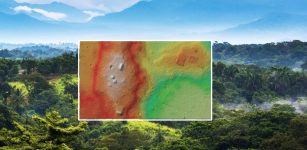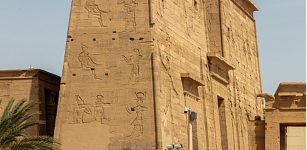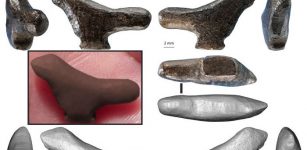Drones Find Evidence Roman Siege Of Masada Lasted Much Shorter Than Previously Thought
Conny Waters - AncientPages.com - The ancient Masada stronghold is situated on an isolated rock plateau at the western end of the Judean Desert, near the Dead Sea's western shore. This site was the last stand against the Roman Empire following Jerusalem's fall in 70 AD. The Siege of Masada by Roman troops concluded with the mass suicide of 960 Jewish rebels and their families who had taken refuge there.
Aerial view of Masada. Credit: Andrew Shiva - CC BY-SA 4.0
Contrary to long-held beliefs that the siege lasted for years, a recent study has provided new insights. Researchers from the Sonia & Marco Nadler Institute of Archaeology at Tel Aviv University employed modern technologies such as drones, remote sensing, and 3D digital modeling to conduct an objective and quantified analysis of the Roman siege system at Masada.
Dr. Guy Stiebel explains, "In 2017 my expedition renewed, on behalf of TAU's Sonia & Marco Nadler Institute of Archaeology, excavations at Masada—a world-famous site explored extensively since the early 19th century and throughout the 20th century. Our expedition sets forward several new questions and implements many novel research tools that were not available to previous generations of archaeologists. In this way we intend to obtain fresh insights into what actually happened there before, during, and after the Great Jewish Revolt.
"As part of this extensive project, we devote much scholarly attention to the site's surroundings. We use drones, remote sensing, and aerial photography to collect accurate high-resolution data from Masada and its environs, with special emphasis on three aspects: the water systems, the trails leading to and from the palatial fortress, and the Roman siege system.
"The collected information is used to build 3D digital models that provide us with a clear and precise image of the relevant terrain. In the current study we focused on the siege system, which—thanks to the remote location and desert climate—is the best-preserved Roman siege system in the world."
He adds, "For many years, the prevailing theory that became a modern myth asserted that the Roman siege of Masada was a grueling three-year affair. In recent decades, researchers have begun to challenge this notion, for various reasons. In this first-of-its kind study, we examined the issue with modern technologies enabling precise objective measurements."
The researchers used drones carrying remote sensors that provided precise, high-resolution measurements of the height, width, and length of all features of the siege system. This data was used to build an accurate 3D digital model, enabling exact calculation of the structures' volume and how long it took to build them.
Dr. Ashkenazi continues, "Reliable estimates are available of the quantity of earth and stones a Roman soldier was able to move in one day. We also know that approximately 6,000–8,000 soldiers participated in the siege of Masada. Thus, we were able to objectively calculate how long it took them to build the entire siege system—eight camps and a stone wall surrounding most of the site. We found that construction took merely about two weeks.
"Based on the ancient historical testimony, it is clear that once the assault ramp was completed, the Romans launched a brutal attack, ultimately capturing the fortress within a few weeks at the most. This leads us to the conclusion that the entire siege of Masada lasted no more than several weeks."
Tower 10 and the wall abutting it. Credit: The Neustadter Masada Expedition (Taken from the Journal of Roman Archaeology)
Dr. Stiebel says, "The narrative of Masada, the Great Jewish Revolt, the siege, and the tragic end as related by Flavius Josephus, have all become part of Israeli DNA and the Zionist ethos, and are well known around the world. The duration of the siege is a major element in this narrative, suggesting that the glorious Roman army found it very difficult to take the fortress and crush its defenders. For many years it was assumed that the siege took three long years, but in recent decades researchers have begun to challenge this unfounded belief.
"In our first-of-its-kind study we used objective measurements and advanced technologies to clarify this issue with the first data-driven scientific answer. Based on our findings, we argue that the Roman siege of Masada took a few weeks at the most. As empires throughout history have done, the Romans came, saw, and conquered, quickly and brutally quelling the uprising in this remote location.
See also: More Archaeology News
"Our conclusion, however, detracts nothing from the importance of this historical event, and many baffling questions remain to be investigated. For example, why did the Romans put so much effort into seizing this remote and seemingly unimportant fortress?
"To answer this and many other intriguing questions, we have initiated a vast, innovative project in and around Masada—collecting data and analyzing it thoroughly in the labs of TAU's Sonia & Marco Nadler Institute of Archaeology, in collaboration with other researchers, to ultimately shed new light on the old enigma: What really happened at Masada?"
The study was published in the Journal of Roman Archaeology
Written by Conny Waters - AncientPages.com Staff Writer






















